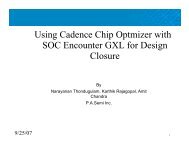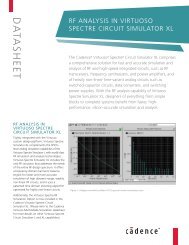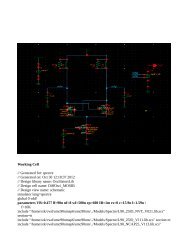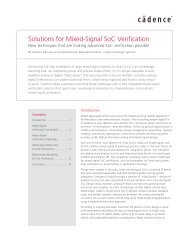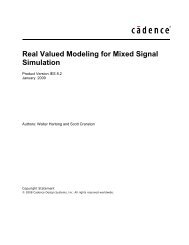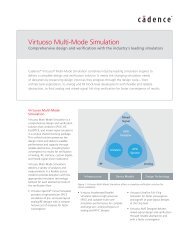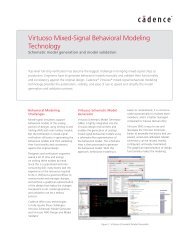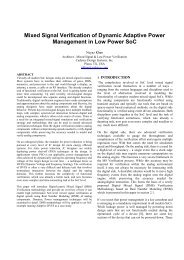Solutions for Mixed-Signal SoC Implementation - Cadence Design ...
Solutions for Mixed-Signal SoC Implementation - Cadence Design ...
Solutions for Mixed-Signal SoC Implementation - Cadence Design ...
You also want an ePaper? Increase the reach of your titles
YUMPU automatically turns print PDFs into web optimized ePapers that Google loves.
Some desirable characteristics of a mixed-signal implementation solution include the following:<br />
• The ability of digital designers to “push into” analog blocks and view their layouts<br />
• The ability <strong>for</strong> analog designers to implement digital functionality within their hierarchical floorplan<br />
• A common design database, such as OpenAccess, instead of a more limited layout representation using<br />
LEF/DEF or GDSII file transfers of analog or digital blocks<br />
• A chip planning capability such as the <strong>Cadence</strong> Chip Planning System that allows users to select analog,<br />
digital and mixed/signal IP and obtain early estimates of size, power consumption, per<strong>for</strong>mance and cost<br />
• A common design constraint definition <strong>for</strong> digital and analog, such that constraints developed on either side<br />
can be understood on the other side<br />
• A mixed-signal router that can understand analog constraints such as symmetry and differential pair routing<br />
• Routing solutions that can optimize the routes <strong>for</strong> yield (DFY) objectives<br />
• A capability to extract digital paths in analog blocks <strong>for</strong> static timing analysis, so that analog designers don’t<br />
have to manually build complex .lib files<br />
• The ability <strong>for</strong> analog designers to prevent editing of their sensitive, finely tuned circuits by <strong>SoC</strong> integrators.<br />
• A hierarchical design approach that can manage analog and digital design styles<br />
In addition to meeting specific demands related to mixed-signal integration, a mixed-signal design flow must<br />
provide the per<strong>for</strong>mance and capacity needed <strong>for</strong> today’s extremely large and dense <strong>SoC</strong> designs, and must<br />
meet all the design <strong>for</strong> manufacturability (DFM) requirements of advanced process nodes. It must also support<br />
low-power design <strong>for</strong> both digital and analog IP.<br />
<strong>Mixed</strong>-<strong>Signal</strong> <strong>Implementation</strong> Flows<br />
As previously noted, there are two types of established mixed-signal implementation flows:<br />
• Schematic-driven flows, in which a custom design environment such as the Virtuoso Layout Suite plat<strong>for</strong>m<br />
handles the floorplanning, chip assembly and block integration. Digital blocks are custom designed or imported<br />
from a digital design environment such as <strong>Cadence</strong> Encounter ® Digital <strong>Implementation</strong> system.<br />
• Netlist-driven (Verilog/VHDL) flows, in which the floorplanning, chip assembly and block integration are handled<br />
in a digital design system. Hardened analog IP blocks are imported from an analog/custom design environment<br />
such as the Virtuoso Layout Suite.<br />
Today’s growing and ever-changing mixed-signal requirements demand that these established flows evolve into<br />
flows where floorplanning and chip assembly are shared between the analog and digital design teams, and where<br />
both analog and digital blocks are developed concurrently, requiring extended flexibility in implementation.<br />
The schematic-driven flow<br />
<strong>Solutions</strong> <strong>for</strong> <strong>Mixed</strong>-<strong>Signal</strong> <strong>SoC</strong> <strong>Implementation</strong><br />
This type of flow is driven by schematic entry and makes extensive use of constraints. Custom designers often<br />
draw schematics <strong>for</strong> full-chip block-assembly as well as smaller, hierarchical digital blocks, and may use custom<br />
generators <strong>for</strong> complex datapath and array based modules. For larger digital blocks, an increasing number of<br />
design teams start with Verilog HDL code, making it possible to take advantage of digital synthesis, placement and<br />
routing. The <strong>Cadence</strong> Virtuoso plat<strong>for</strong>m provides a utility that translates a schematic into a Verilog netlist.<br />
A more detailed look at the schematic-driven mixed-signal flow is shown in Fig. 3. Here, the orange coloring<br />
identifies tasks typically done in an analog/custom environment, while blue coloring indicates tasks typically<br />
done in a digital IC design environment.<br />
www.cadence.com 4






